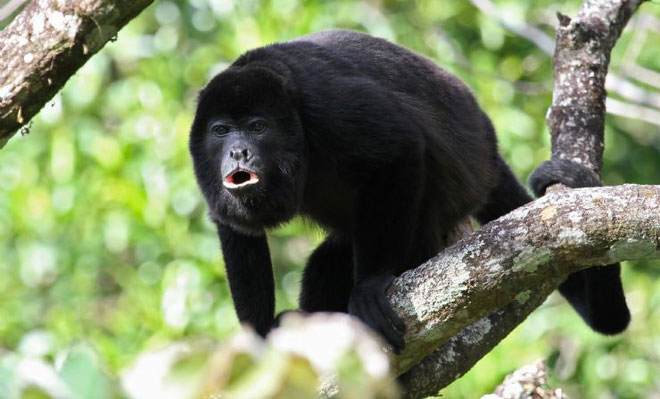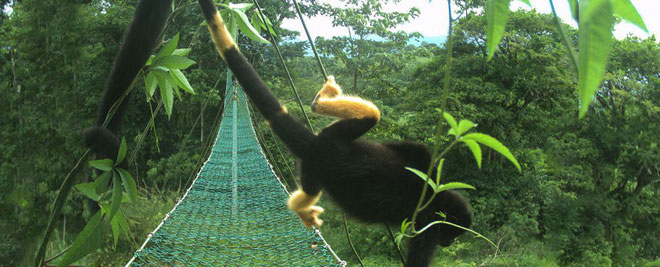The sad truth behind the black-bodied species is gradually turning yellow
Starting from the limbs, spreading to the back and tail, then even the monkeys turned yellow and their names were black monkeys. What is the reason?
In Central and South America is the black mantled howler monkey , with the scientific name of Alouatta palliata. Just as the name suggests, except for a few orange feathers behind it, their whole body is covered with a jet of black fur.

Black howling monkey.
However, the black monkey group in Costa Rica alone has a strange phenomenon. Their feathers are gradually turning yellow and this phenomenon has only happened in the last 5 years.
Currently, experts have confirmed at least 21 cases of black howling monkeys bearing yellow fur in the forests of Costa Rica. First, the "yellowing" process only occurs in the limbs. Some tails also turn yellow. However, over time, yellow patches begin to appear more, spreading down the back. And even, there are at least 2 black monkeys but the whole body is yellow.
The cause of this change has led scientists to find out for many years. So far they had a clue, only regrettably it revealed a sad truth behind it, because the culprit could be . human pesticides.
In particular, experts from Spain's Donana Biological Station analyzed the hair structure of some yellow-black monkeys, and they found a difference in the concentration of melanin produced .

Black monkey hairs gradually turn yellow.
Melanin - or melanin - is the pigment that determines the color of our skin and hair. Depending on the concentration and structure of the melanin formation, the color of the hair will be different. For this monkey species, melanin has for some reason transformed into pheomelanin, making their feathers turn yellow, red or orange rather than black.
"Observations show abnormalities in pigment production, and this is something that has never been seen in this monkey," said study author Ismael Galván.
"We have never seen this phenomenon in other primates."
This is the first time that science has recorded the color of a primates' hair color that can change in such a short time. The reason behind is not really clear, but the theory is that it is a pesticide.
Why do you suspect pesticides?
Because when examining the yellow fur, experts discovered that inside they contained sulfur - the foundation of the myriad of insecticides being used in the world.
According to Galván, this may be evidence that Costa Rican monkeys are being exposed to too many pesticides, and that has changed the pigment on their feathers. The melanin structure is altered, and the color changes accordingly.
Doubts of experts are in fact based. In Costa Rica, farmers use sulfur-based pesticides in large quantities in pineapple gardens, banana gardens and palm oil farms. And most "strange" creatures are found around these farms.

Costa Rica is the place to use the most pesticides in the world.
Moreover, Costa Rica is also the place to use the most pesticides in the world, with about 25kg of medicine per hectare of land.
Returning to the black howling monkeys, they regularly eat leaves around the farm, which means that the animal has absorbed a very large amount of pesticides, and thus affects their melanin structure. .
However, according to Galván, this is not the final conclusion. We will need more research in the future to confirm it. It's just that these studies need to be done quickly, because even though the change in color looks harmless, they make it harder for this monkey to hide from the enemy. While they are already in the IUCN endangered list.
The study is published in the journal Mammalian Biology.
- The scary truth about black ice near the Arctic
- The truth about the use of black art is less known
- Why are yellow-spotted fish sold at high prices?
- Mysterious deciphers' autumn leaves fall yellow
- Discovered 2 species of yellow lilies tea for science at Vu Quang National Park
- Detecting tooth toads, frogs clinging to rare yellow spotted stone in Lao Cai
- Black or yellow turmeric better?
- Researching the 'dead sound' of black holes
- Yellow urine warns what you already know?
- Detecting a poisonous snake with horns
- Mercury is no different from a raisin fruit turning around the Sun.
- 17 'truth' about the Earth and the universe is true but has been rejected by science
 Animal 'suffering' after hibernation
Animal 'suffering' after hibernation Why do goats climb well?
Why do goats climb well? Scientists were surprised to see chimpanzees eating turtles
Scientists were surprised to see chimpanzees eating turtles Giant catfish died deadly due to drought in Thailand
Giant catfish died deadly due to drought in Thailand